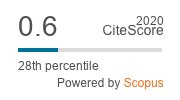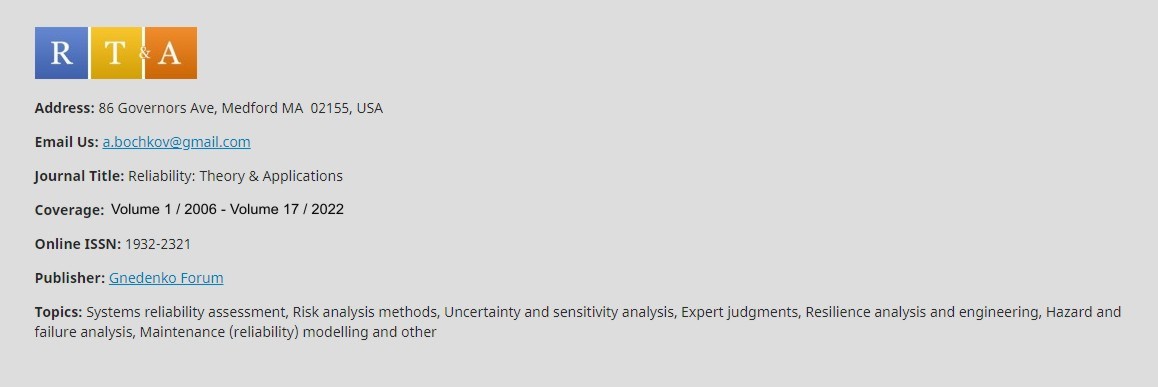|
About Us | Submission | Editorial Team | Privacy Statement | Current Issue | Templates & Author Guidelines | Archives | Contacts
|
||
|
|
GHEORGY KONSTANTINOVICH MISCOY (09.01.1944-12.09.2020)
On the12-th of September 2020 passed away Gheorghe Mishkoy, outstanding scientist, teacher, applied statistician, friend. His scientific degree was habilitated Doctor of Physics and mathematics, professor, academician at the Academy of Science of Moldova. Illustrious scientist, mathematician, academician Gheorghe MISHKOY contributed to the development and strengthening of the applied mathematics. And he did this nationally and internationally during his 49 years of active, fruitful scientific, pedagogical and management remarkable work. The loss of Academician Gheorghe MISHKOY is huge for the entire scientific community and for the society in Republic of Moldova. In these difficult moments, we express our sincere condolences.
DOI: https://doi.org/10.24411/1932-2321-2020-14001
Yu. Paramonov
A simple method is proposed for obtaining such a description of the average fatigue curve (and residual static strength) of a unidirectional fiber composite (UFC), which is directly related to the parameters of the static strength distribution of its components (SSDC), which are the longitudinal items bearing the main longitudinal load. This description makes it possible to predict changes in the fatigue life of the UFC when the SSDC changes. The method is based on a Daniels_epsilon_sequence (DeS), which is a modification of Daniels_sequence (DS) which considers the short-term damaging effects of one separate cycle of fatigue loading. Here we use a specific version of it in which the number of components of a critical link of UFC is equal to infinity. We call this version as simplified DeS. The concept of a DeS_fatigue equivalent distribution (DeS_FED) of local static strength of LI is introduced. The DS the calculations of fatigue life using the DeS_FED coinside with the test data. The simplified DeS model studied in this article should be used for preliminary analysis of the mean SN curve. For the more detailed analysis should be used the models considered by author some earlier which include the use of the theory of Markov processes and the Monte Carlo method, which allows modeling and statistical aspects of the problems under consideration but require much more time-consuming calculations. At the end of the paper a numerical example of processing the fatigue test data and prediction a new fatigue life at some SSDC changes are given.
DOI: https://doi.org/10.24411/1932-2321-2020-14002
Surabhi Sengar SENSITIVITY ANALYSIS OF A COMPLEX ENGINEERING SYSTEM WITH THE APPLICATION OF WAIT IN LINE THEORY
In this bloodthirsty scenario of competition, rapid and cost-effective production is a key obligation for endurance. To attain this objective the thought of production area is fetching people now days. In this sector, non- identical equipment are arranged rationally to execute desired procedure to convert unprocessed materials into the processed material. Sometimes during the manufacturing, the problem of waiting line arises because of some unpredictable reasons, so here this paper reveals the same problem with its effects on system reliability and availability, also system sensitive nature is analyzed with respect to unexpected failures. Supplementary variable technique and copula method is used to solve the system.
DOI: https://doi.org/10.24411/1932-2321-2020-14003
S.R. Sruthi, Dr.P.R. Jayashree RAM ANALYSIS OF ER/M/1/N PHASE-TYPE QUEUEING SYSTEM WITH WORKING AND WORKING-BREAKDOWN STATES
In this paper, the Reliability, Availability and Maintainability (RAM) analysis for the finite capacity Erlangian Phase-type Queueing model is studied with regard to failure and recovery rates. The arrival process of the machines to repair is assumed to follow Erlang distribution and the service process is exponentially distributed in FCFS discipline. Apart from the multi-phases in the queueing system two different environmental states such as the working and working-breakdown states were also taken into consideration. The transient state differential-difference equations for the general case and for the special case of N=5 is obtained. The results are presented numerically and graphically along with some special metrics such as MTBF and MTTR. The sensitivity analysis is also performed to find changes in different parametric values for the model.
DOI: https://doi.org/10.24411/1932-2321-2020-14004
Mustafa Kamal, Ahmadur Rahman*, Saiful Islam Ansari, Shazia Zarrin
In this study we have considered step stress accelerated life testing plan for complete data. The lifetimes of the failure items are assumed to follow Nadarajah-Haghighi distribution which is an extension of exponential distribution and has all the properties like Weibull, gamma exponentiated exponential distribution. The maximum likelihood estimates of the parameters and accelerated factors have been estimated and confidence intervals of these parameters are also obtained. Newton-Raphson iterative procedure is used to solve the non-linear equations which are not in closed form. Later, a simulation study has been performed to check the performance of the parameters and hence the theory of the paper.
DOI: https://doi.org/10.24411/1932-2321-2020-14005
Tijjani A. Waziri, Ibrahim Yusuf ON AGE REPLACEMENT POLICY OF A SYSTEM INVOLVING MINIMAL REPAIR
This paper made a survey on age replacement model involving minimal repair, and this was done by considering a parallel-series system with two subsystems, which are subsystems A and B, and each of the system is formed by three parallel units, therefore, the whole systems consist of six units. We constructed age replacement model involving minimal repair that will determine the optimal replacement time of the parallel-series system based on two different policies (Policy 1 and Policy 2). A numerical example was given to illustrate the characteristics of the age replacement models involving minimal repair constructed. From the results obtained, it was observed that policy 2 extends the optimal replacement time of a multi-component system, when compared to Policy 1.
DOI: https://doi.org/10.24411/1932-2321-2020-14006
Jaykumar Shantilal Patel KEY MANAGEMENT AND DISTRIBUTION FOR MOBILE AD-HOC NETWORK
Security has become the principal concern in mobile ad-hoc network. Secure communication depends on using cryptographic mechanisms. Cryptographic mechanism involves symmetric key and asymmetric key approaches. The symmetric key approach is more reliable except the key distribution phase. Asymmetric key approach gives robust security, but it results in high computational, high communications and high storage overhead. The propose research uses both the concepts. The symmetric key approach for reliable data exchange and asymmetric key approach for key management and distribution to achieve robust security in constraint based mobile ad-hoc network.
DOI: https://doi.org/10.24411/1932-2321-2020-14007
Diwakar Shukla and Sarla More
The problem of ready queue mean time estimation in the multiprocessor environment was discussed by Shukla et. al. [5] and several others. In recent years, most of the existing and relating contributions assume that all processes in the ready queue might have been completed before a particular instant of time occur like a sudden failure or interrupt. Due to this, data of time consumed by processes remain available. The idea of improvement in this paper is to assume that at the instant of occurrence of breakdown, some processes are partially completed and remaining is completely processed. Under this situation, the time computation and allocation strategies need to be re-designed. Therefore, this has been taken into account in this paper with a proposal of a modified scheme. It contains arbitrary, Type-A, and Type- B allocations of sample units to the processors. Confidence intervals for the sample mean values are calculated and simulated over many samples using cumulative probabilities. It was found that Type-A allocation has the lowest variance.
DOI: https://doi.org/10.24411/1932-2321-2020-14008
Yung-Fu Cheng EM ALGORITHM FOR ESTIMATING THE BURR XII PARAMETERS IN PARTIALLY ACCELERATED LIFE TESTS
In this paper, I present maximum likelihood estimation via the expectation-maximization algorithm to estimate the Burr XII parameters and acceleration factor in step-stress partially accelerated life tests under multiple censored data. In addition, the asymptotic variance and covariance matrix of the estimators are derived by using the complete and missing information matrices, and confidence intervals of the parameters are obtained. The simulation results show that the maximum likelihood estimation via the expectation-maximization algorithm performs well in most cases in terms of the absolute relative bias, the root mean square error, and the coverage rate. Furthermore, a numerical example is also given to demonstrate the performance of the proposed method.
DOI: https://doi.org/10.24411/1932-2321-2020-14009
P. Vijaya Laxmi, E. Girija Bhavani and Rakesh Kumar CORRELATED RENEGING IN AN OPTIONAL SERVICE MARKOVIAN QUEUE WITH WORKING VACATIONS
This paper studies an queueing system with second optional service, correlated reneging and working vacations. All arriving customers require the first essential service whereas only a portion of them require a second optional service. The matrix geometric method is used to compute the stationary probability distribution of the system size. Further, various system performance measures are obtained and a cost optimization problem is considered using bat algorithm (BA). A variety of numerical illustrations are summarized in tables and graphs to provide an insight into the performance characteristics of the studied model.
DOI: https://doi.org/10.24411/1932-2321-2020-14010
Shubham Gupta, Pradeep Chaudhary and Vaishali A THREE UNIT WARM AND COLD STANDBY SYSTEM MODEL OF DISCRETE PARAMETRIC MARKOV CHAIN
The paper deals with cost benefit analysis of a threeidentical unit cold and warm standby system model. Each unit has two modes- normal (N) and total failure (F). The warm standby unit becomes operative instantaneously upon the failure of an operative unit, whereas cold standby unit needs activation to become operative or to be warm standby. A single repairman is always available to repair a failed unit. The activation of a cold standby unit is made by the operator itself. The distributions of time to failure, time to repair and activation time are taken as independent random variables of discrete nature having geometric distributions with different parameters.
DOI: https://doi.org/10.24411/1932-2321-2020-14011
M. I. G. Suranga Sampath, Rakesh Kumar, Bhavneet Singh Soodan, Jicheng Liu and Sapana Sharma
In this paper, a finite capacity two heterogeneous servers’ queuing system with retention of reneging customers is studied. The explicit transient probabilities of system size are obtained using matrix method. Further, the time-dependent mean and variance are presented. Finally, a numerical example is provided to show the behavior of the system.
DOI: https://doi.org/10.24411/1932-2321-2020-14012
Muhammad Salihu Isa, U A Ali, Bashir Yusuf, Ibrahim Yusuf, Yusuf Jamilu Umar SENSITIVITY ANALYSIS OF THREE DIFFERENT SERIES – PARALLEL DYNAMO CONFIGURATIONS
This paper deals with the sensitivity analysis of three configurations arranged in series parallel. Configuration I consist of six units in which four are on operation while two are on standby. Configuration II consist of seven units with three of the units are on standby while the remaining four are on operation. Configuration III comprises of two subsystems C and D with three unit in each subsystem with a unit on standby. Units in each configuration provide 25MW. Both the failure and repair time are assumed exponentially distributed. System of first order linear differential difference equations is obtained using the transition diagram. Explicit expressions of the system availability, Mean Time To Failure (MTTF), busy period due to partial failure, busy period due to complete failure and profit were derived. Furthermore, results of sensitivity of the system availability, MTTF and profit were determined. The obtained results were analyzed and compared, configuration I was found to be the optimal configuration.
DOI: https://doi.org/10.24411/1932-2321-2020-14013
|
Safety Research :
Safety, Risk, Reliability and Quality:
Statistic, Probability and Uncertainty :
|
|
|
|
|
|
|
||







.png)
.png)
